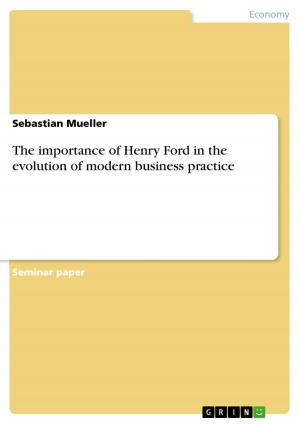Mercedes Benz - How A Great Campaign Can Almost Kill A Company
How A Great Campaign Can Almost Kill A Company
Business & Finance, Marketing & Sales| Author: | Carolin Biebrach | ISBN: | 9783640360390 |
| Publisher: | GRIN Publishing | Publication: | June 29, 2009 |
| Imprint: | GRIN Publishing | Language: | English |
| Author: | Carolin Biebrach |
| ISBN: | 9783640360390 |
| Publisher: | GRIN Publishing |
| Publication: | June 29, 2009 |
| Imprint: | GRIN Publishing |
| Language: | English |
Essay from the year 2009 in the subject Communications - Public Relations, Advertising, Marketing, Social Media, grade: A, Ohio University (E.W. Scripps School of Journalism), course: International and Crosscultural Advertising, language: English, abstract: What started as one of the biggest and most expensive campaigns in the German automobile industry, almost ended in a disaster for the company. The result was the biggest crisis, a German automobile company had ever faced. Mercedes-Benz is a high-class automobile company. Its products stand for luxury, reliability and dependability. But high-class cars are expensive and only affordable for the richer part of society. To keep pace with the fast developing automobile industry all over the world, Mercedes-Benz decided to invent car that reunites all three values, the company embraces. This car - the Mercedes-Benz A-Class - should have another important feature: It is affordable for the middle class. With this car, Mercedes was approaching a new market segment and therefore new target audiences. A campaign, that fits the new car in the overall Mercedes image, was crucial. In May 1996 Mercedes Benz started its huge advertising campaign - almost one and a half years prior to the official product launch on October 18th 1997. More than 100 million Euro will this launching campaign cost the company. Despite that the campaign only ran in the European market, the Mercedes-Benz brand and this specific campaign caught international attention. Newspapers from all over the world accompanied the A-Class until its official launch. These newspapers were also there, when the crisis occurred, that almost harmed the company on a long-term basis. Right after the launch, the car, that was supposed to be innovative, reliable and safe, failed in the so called 'moose-test'. After almost two years of positive media coverage, a flood of criticism followed. Due to the high level of awareness for the car, the public was now also aware of the safety issues the Mercedes A-Class had. What followed was another campaign. The goals were to safe the image of the company, to deal with the crisis and to re-launch the A-Class half a year later. The campaign analysis explains why Mercedes had to take the approach and step into the market segment of small cars. In addition, the launching campaign and its four phases: Big Bang, New Perspectives, New Choices, and New Experiences, will be explained in detail. The second part will cover the crisis that occurred after the launch of the A-Class and the re-launch in 1998. Finally, the analysis will show whether this incident harmed the image of the company on a long-term basis, and how advertising influenced this development.
Essay from the year 2009 in the subject Communications - Public Relations, Advertising, Marketing, Social Media, grade: A, Ohio University (E.W. Scripps School of Journalism), course: International and Crosscultural Advertising, language: English, abstract: What started as one of the biggest and most expensive campaigns in the German automobile industry, almost ended in a disaster for the company. The result was the biggest crisis, a German automobile company had ever faced. Mercedes-Benz is a high-class automobile company. Its products stand for luxury, reliability and dependability. But high-class cars are expensive and only affordable for the richer part of society. To keep pace with the fast developing automobile industry all over the world, Mercedes-Benz decided to invent car that reunites all three values, the company embraces. This car - the Mercedes-Benz A-Class - should have another important feature: It is affordable for the middle class. With this car, Mercedes was approaching a new market segment and therefore new target audiences. A campaign, that fits the new car in the overall Mercedes image, was crucial. In May 1996 Mercedes Benz started its huge advertising campaign - almost one and a half years prior to the official product launch on October 18th 1997. More than 100 million Euro will this launching campaign cost the company. Despite that the campaign only ran in the European market, the Mercedes-Benz brand and this specific campaign caught international attention. Newspapers from all over the world accompanied the A-Class until its official launch. These newspapers were also there, when the crisis occurred, that almost harmed the company on a long-term basis. Right after the launch, the car, that was supposed to be innovative, reliable and safe, failed in the so called 'moose-test'. After almost two years of positive media coverage, a flood of criticism followed. Due to the high level of awareness for the car, the public was now also aware of the safety issues the Mercedes A-Class had. What followed was another campaign. The goals were to safe the image of the company, to deal with the crisis and to re-launch the A-Class half a year later. The campaign analysis explains why Mercedes had to take the approach and step into the market segment of small cars. In addition, the launching campaign and its four phases: Big Bang, New Perspectives, New Choices, and New Experiences, will be explained in detail. The second part will cover the crisis that occurred after the launch of the A-Class and the re-launch in 1998. Finally, the analysis will show whether this incident harmed the image of the company on a long-term basis, and how advertising influenced this development.















